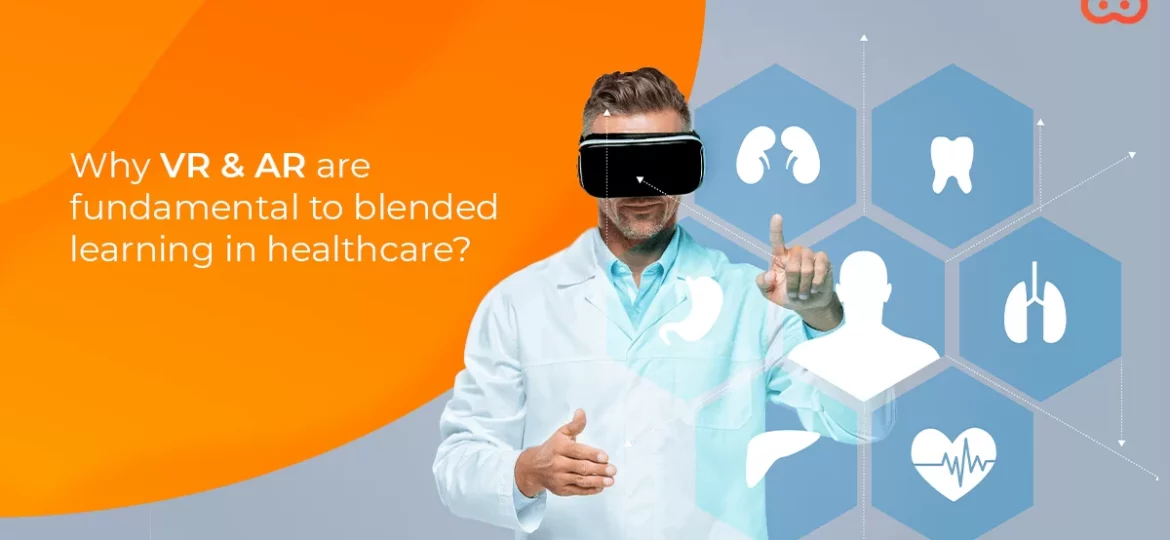
The concept of blended learning combines in-person and virtual classroom settings, resulting in a multimodal experience that combines two or more learning modes. Probably the most valuable lesson learned from the pandemic era, especially for the L&D (learning and development) or EdTech industry, is that training must be adaptive while maintaining high engagement levels. Virtual reality and augmented reality technologies are promising additions to this space due to their immersive nature, capacity to share information in new ways, and potential for offering virtual experiences that can mitigate barriers of cost or distance.
The slow pace of traditional learning often exhausts students, resulting in lesser engagement. According to the Center for Digital Education, 73% of teachers who employ blended learning say their students are more engaged in the blended learning approach.
This article will venture through the benefits of AR/VR in blended learning and some practical applications of these two promising technologies in healthcare and other sectors.
The benefits of using VR/AR in blended learning
Blended learning is a type of training that incorporates a variety of learning methods. Virtual and augmented reality are some of the most useful technologies for supporting blended learning as they allow fully immersive experiences. In higher education, augmented and virtual reality can help students grasp abstract concepts and gain hands-on experience in low-risk virtual environments. STEM courses, medical simulations, arts and humanities materials, and technical education can benefit from this. It is no surprise that L&D professionals from a variety of industries, including medical, retail, automotive, and warehousing, are also investing in AR/VR training.
Immersive learning can be leveraged to
- Reinforcing hands-on learning
- Practicing skills in a safe learning environment through interactive activities
- Consistent scaling across locations
- Access to a unique set of metrics
AR/VR in medical training
To prepare students for everything from interacting with patients to completing complex procedures, medical education necessitates a large amount of hands-on, in-person learning. AR/VR technologies are increasingly being used by medical and health care educators to give low-cost, low-risk, and often more participatory alternatives to traditional approaches in this profession.
Applications of blended learning in healthcare
The Master of Oncoplastic Breast Surgery program at the University of East Anglia is designed for advanced surgical trainees working in accredited training centers in the United Kingdom and worldwide. It consists of a series of challenging cases students discuss in an online, asynchronous discussion forum overseen by a faculty member. Despite varying clinical rotas and time zones, students can engage whenever it is convenient for them. A similar tendency emerged in the trainees’ self-ratings of confidence in dealing with eight typical surgical crises. This case study demonstrates that highly interactive online learning complements traditional postgraduate clinical training. After the successful implementation of the master’s program, other blended learning projects have been developed, such as nurse associate training and breast care nursing in the UK and other developing countries.
Applications of blended learning apart from healthcare
Besides medical training, the blended learning approach has also gained momentum after successful applications in leadership, warehouse, and corporate training. We have outlined real-world examples of how learners perceive and benefit from this new approach.
Blended learning for leadership training
One financial organization identified a thorough, scalable, and interactive leadership program as a requirement. The corporation developed a new program that taught learners the organization’s standard for leadership behavior through a blended learning approach that included virtual instructor-led training (VILT), 360-degree VR, and pre-and post-session activities.
In virtual-instructor-led training, the learners completed an 8-week program with 90-minute sessions using virtual platform functionalities such as break-out rooms for small group discussions. As per learners, these sessions help evoke critical thinking through conversations despite sitting in remote locations. The activities participants completed were reading articles, watching videos, and writing in virtual journals, enhancing their VILT sessions. Learners experienced 360-degree VR, which allowed them to navigate realistic scenarios, practice making decisions, and receive feedback on their choices. Overall, the experience was highly satisfying for training the leaders using immersive technologies.
Reimagining corporate training with blended learning
Training and development are more crucial than ever for most corporates to equip employees with the skills they need to adapt to the hybrid work environment. This is where blended learning came to the rescue. Virtual and augmented reality offer limitless possibilities for workplace training, ranging from fundamental manual labor practices to high-level executive leadership development. Thus, AR/VR has become essential in blended learning for corporates as it allows them to provide completely immersive virtual training sessions for their employees without the risk or expense of transporting them to a risky location or a remote location.
In conclusion
The spread of blended learning during the COVID pandemic has forced widespread adoption and demonstrated its benefits to a large number of users. It will likely remain a mainstay of healthcare education in the future. Meanwhile, modern technologies such as AR/VR are relatively new, but it already has a lot to offer in e-learning. It is not too early to predict that these technologies will become more prevalent in blended learning curricula in the future.

